【精选】人教版七年级英语下册Unit10(第十单元)优秀教案
- 格式:doc
- 大小:77.50 KB
- 文档页数:16
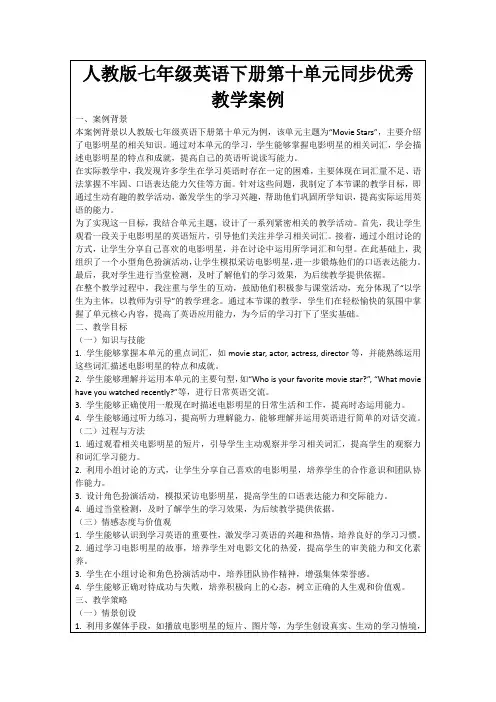
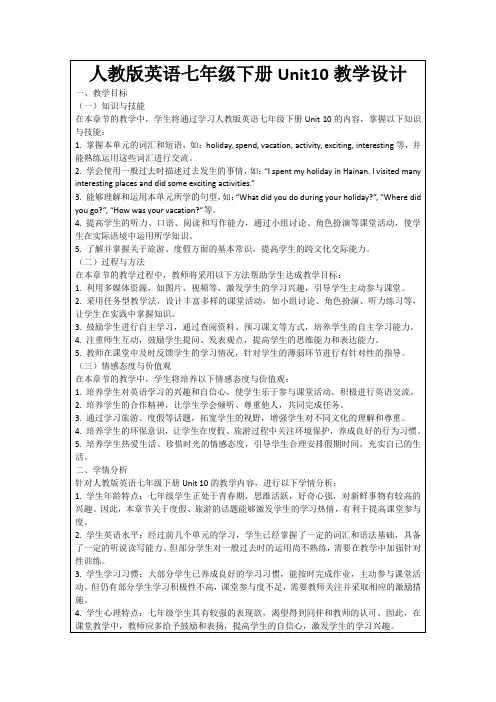

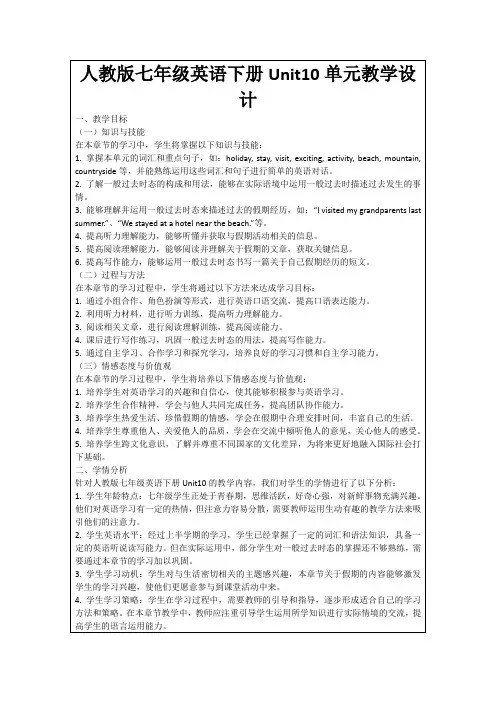
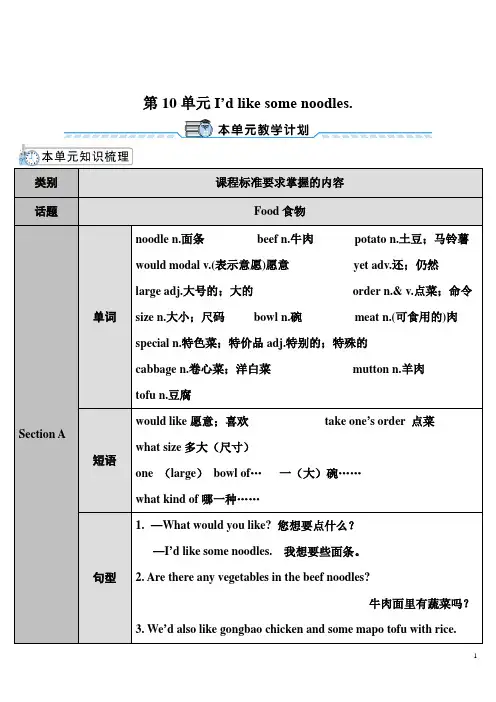
第10单元I’d like some noodles.类别课程标准要求掌握的内容话题Food食物Section A 单词noodle n.面条beef n.牛肉potato n.土豆;马铃薯would modal v.(表示意愿)愿意yet adv.还;仍然large adj.大号的;大的order n.& v.点菜;命令size n.大小;尺码bowl n.碗meat n.(可食用的)肉special n.特色菜;特价品adj.特别的;特殊的cabbage n.卷心菜;洋白菜mutton n.羊肉tofu n.豆腐短语would like愿意;喜欢take one’s order 点菜what size多大(尺寸)one (large)bowl of…一(大)碗……what kind of哪一种……句型1.—What would you like? 您想要点什么?—I’d like some noodles. 我想要些面条。
2. Are there any vegetables in the beef noodles?牛肉面里有蔬菜吗?3. We’d also like gongbao chicken and some mapo tofu with rice.句型1. The number of candles is the person’s age.蜡烛的数量是过生日的人的年龄。
2. If he or she blows out all the candles in one go,the wish will come true. 如果他/她一口气吹灭所有的蜡烛,许的愿望便会成真。
3. They never cut up the noodles because the long noodles are a symbol of long life. 他们从不切碎面条,因为长长的面条是长寿的象征。
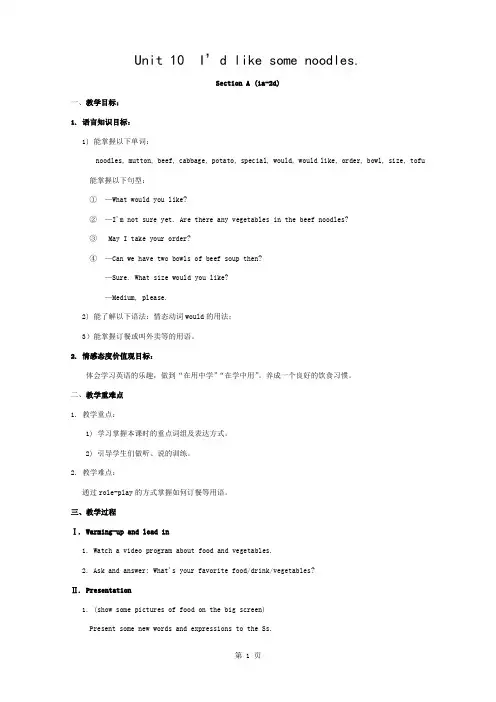
Unit 10 I’d like some noodles.Section A (1a-2d)一、教学目标:1. 语言知识目标:1) 能掌握以下单词:noodles, mutton, beef, cabbage, potato, special, would, would like, order, bowl, size, tofu 能掌握以下句型:①—What would you like?②—I'm not sure yet. Are there any vegetables in the beef noodles?③ May I take your order?④—Can we have two bowls of beef soup then?—Sure. What size would you like?—Medium, please.2) 能了解以下语法:情态动词would的用法;3)能掌握订餐或叫外卖等的用语。
2. 情感态度价值观目标:体会学习英语的乐趣,做到“在用中学”“在学中用”。
养成一个良好的饮食习惯。
二、教学重难点1. 教学重点:1) 学习掌握本课时的重点词组及表达方式。
2) 引导学生们做听、说的训练。
2. 教学难点:通过role-play的方式掌握如何订餐等用语。
三、教学过程Ⅰ. Warming-up and lead in1. Watch a video program about food and vegetables.2. Ask and answer: What's your favorite food/drink/vegetables?Ⅱ. Presentation1. (show some pictures of food on the big screen)Present some new words and expressions to the Ss.2. Ss learn the new words and expressions by themselves and try to remember them.3. Work on 1a:Read the words on the left and look at the pictures on the right. Write the letters of the food on the line. Then check the answers.Ⅲ. Game (Guess the food.)(Show some pictures of food on the big screen)Let Ss guess what food it is.Ss try to guess the food and learn the words.Ⅳ. ListeningT: In the following conversation, one man is ordering some food. Now, let’s listen to the tape, find out the right noodles the person orders.Play the recording for the Ss to listen and check the answers.Ⅴ. Pair work1. Present the conversation in 1b on the big screen and ask Ss to practice it.2. Make their own conversations using the noodles in the picture.3. Let some pairs act out their conversations.Ⅵ. Listening1. Work on 2a;T: Now, look at the pictures on the right, listen to the conversations and check the names of the foods you hear.(Play the recording for the first time, students only listen carefully.Then, listen to the recording again, and check the names of the foods.Check the answers. )2. Work on 2b:(Play the recording for the Ss to listen and complete the sentences.)Play the recording twice. The first time Ss just listen. And the second time, Ss listen and write down the words.(If necessary, use the pause button to help Ss)3. Check the answers.Ⅶ. Pair work1. Ask and answer questions with your partner. Use the information in 2a.2. Show the conversations of 2a on the big screen to the Ss.3. Make a model for the Ss.T: What kind of noodles would you like?S1: I'd like beef noodles, please.3. Ss work in pairs and practice the conversations.Ⅷ. Role-play1. Ask Ss to read the conversation in 2d and find the answer to this question:What would they like?(They would like one large bowl of beef soup, one gongbao chicken, and one mapo tofu with rice.)2. Check the answers with the Ss.3. Ss work with their partners and role-play the conversation.VIII. Language pointsIX. ExercisesHomework1. Review the words and expressions in this period.2. Role-play the conversation in 2d.3. Write a short conversation to order some noodles you like in a restaurant.板书设计:一、1.2.二、1. 教学重点:1) 总结订餐所用语言及句子结构。
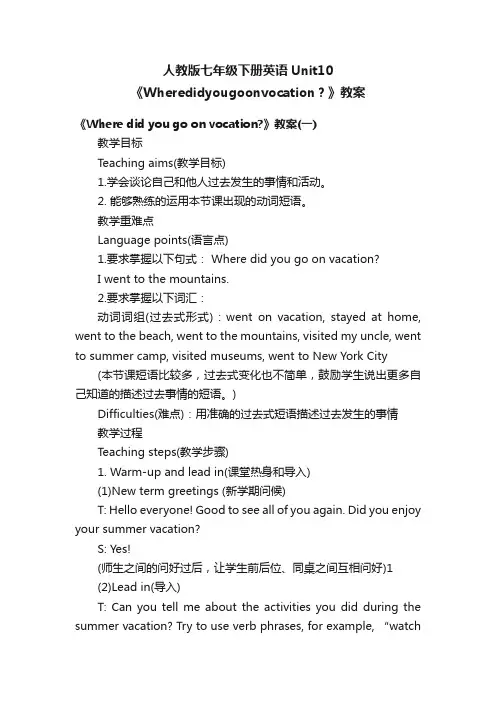
人教版七年级下册英语Unit10《Wheredidyougoonvocation?》教案《Where did you go on vocation?》教案(一)教学目标Teaching aims(教学目标)1.学会谈论自己和他人过去发生的事情和活动。
2. 能够熟练的运用本节课出现的动词短语。
教学重难点Language points(语言点)1.要求掌握以下句式: Where did you go on vacation?I went to the mountains.2.要求掌握以下词汇:动词词组(过去式形式):went on vacation, stayed at home, went to the beach, went to the mountains, visited my uncle, went to summer camp, visited museums, went to New York City (本节课短语比较多,过去式变化也不简单,鼓励学生说出更多自己知道的描述过去事情的短语。
)Difficulties(难点):用准确的过去式短语描述过去发生的事情教学过程Teaching steps(教学步骤)1. Warm-up and lead in(课堂热身和导入)(1)New term greetings (新学期问候)T: Hello everyone! Good to see all of you again. Did you enjoy your summer vacation?S: Yes!(师生之间的问好过后,让学生前后位、同桌之间互相问好)1(2)Lead in(导入)T: Can you tell me about the activities you did during the summer vacation? Try to use verb phrases, for example, “watchTV”.S1: I went shopping.S2: I went to the movies with my friends.S3: I went swimming.(老师可以鼓励学生给出尽可能多的答案,并引导学生使用过去式) T: Wow. It sounds like you had a good time during the summer vacation! I’m sure you enjoyed yourselves very much. Now I want to know where you went on vacation.(教师把“Where did you go on vacation?”和I went/… 板书在黑板上)教学设计说明:从贴近学生熟悉的话题入口,通过对学生暑假生活的了解及回顾,引出今天的重点内容。

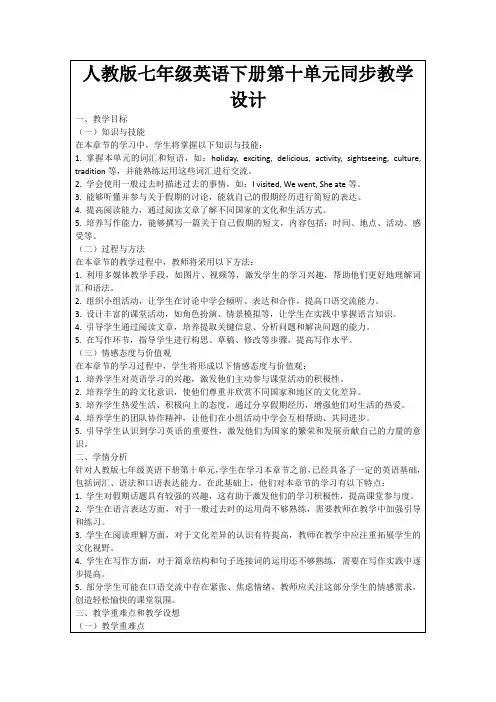

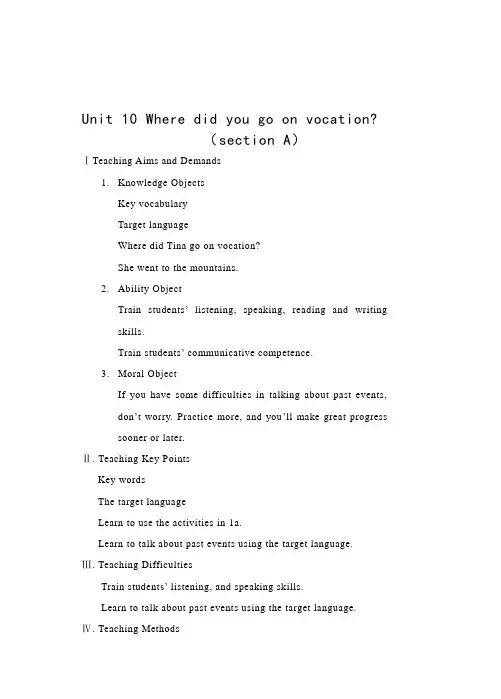
Unit 10 Where did you go on vocation?(section A)ⅠTeaching Aims and Demands1.Knowledge ObjectsKey vocabularyTarget languageWhere did Tina go on vocation?She went to the mountains.2.Ability ObjectTrain students’listening, speaking, reading and writingskills.Train students’ communicative competence.3.Moral ObjectIf you have some difficulties in talking about past events,don’t worry. Practice more, and you’ll make great progresssooner or later.Ⅱ. Teaching Key PointsKey wordsThe target languageLearn to use the activities in 1a.Learn to talk about past events using the target language.Ⅲ. Teaching DifficultiesTrain student s’ listening, and speaking skills.Learn to talk about past events using the target language.Ⅳ. Teaching MethodsScene teaching method.Listening and oral practice methods.Ⅴ. Teaching AidsA tape recorderA computerⅥ. Teaching ProceduresStepⅠGreetingGreet the class as usual.Check the homework.StepⅡ1a 1b1. Each picture shows something a person did I the past.Then ask students to name each activity.2. Play a recording of three conversations. These people aretalking about what they did on vacation. Listen and writethe numbers of the names in the boxes in the picture. StepⅢ1cWork with a partner, make conversations to talk about whatthe people in activity 1a went on vacation.StepⅣ2a 2b1. Play a recording of three conversations. These people aretalking about where they went on vacation. You are to listenand match the person with the place.2. Play the same recording again. Put a check mark under theheadline ” Yes, I did.” or “ No, I don’t.”StepⅤ2c Grammer Focus1. Place students into groups of three. Suppose one of you isNancy, one is Kevin and one is Julie. Now please ask eachother questions to talk about where you went on vacation asin the sample conversation.2. Ask students to read the questions and answers in pairs. StepⅥ3a 3bFill in the blanks with the word “was “ or “were” .Look at the pictures carefully and try to describe each one. StepⅦ 4Works in groups and talk about their photos.StepⅧSummarySummary the target language we’ve learned in this class. StepⅨHomeworkWrite a short passage to talk about one of your vacations.Blackboard DesignUnit 10 Where did you go on your vacation?(section B)ⅠTeaching Aims and Demands1.Knowledge ObjectsKey words.Target language.2.Ability ObjectTrain students’ listening, speaking, reading and writingskills.Train students’ communicative competence.Self-check.3.Moral ObjectⅡ. Teaching Key PointsThe key vocabulary.The target language.Ⅲ. Teaching DifficultiesTrain students’ reading and writing skills.Write a travel diary.Complete a questionnaire and make a survey.Ⅳ. Teaching MethodsListening, reading, writing and speaking methods.Practicing methodsGroup workⅤ. Teaching AidsA computerThe blackboard.Ⅵ. Teaching ProceduresStepⅠGreetingGreet the class as usual.Check the homework.StepⅡ1a 1b1. Point out the numbered list of words in the box. Read themand have students repeat several times.2. Ask, which words are happy words and which are unhappyones? Please put them in the correct blanks.StepⅢ2a 2b1. Listen to a conversation. Vera is talking about her vacation.Please listen and answer the question.2. Play the same recording again. You are to listen and writedown the answers to these things.StepⅣ2cStudent A is Vera’s friend and Student B is Vera. Get studentto role play the conversation in pairs.StepⅤ3a 3b1. Read the diaries carefully by yourselves. Circle the goodthings about the vacation and underline the bad things.2. Imagine you are an American student on vacation in Beijing.Please write a travel diary.StepⅥ 4Place students into groups of five. Imagine you are allforeigners on vacation in China. Take turns telling whatyou did on your vacation.StepⅦSelf-check 1 2 31. Ask students to check all the words they know.2. Ask students to write five new words in theirVocab-builder.3. Help students to make up questions about the topics in theform. Write the questions on a piece of paper.StepⅧSummarySummary the target language we’ve learned in this class. StepⅨHomeworkChoose the most interesting place you have ever been to and write a travel diary.Blackboard Design教学后记:Unit 10 Where did you go on your vacation?复习教案ⅠTeaching Aims and Demands4.Knowledge ObjectsReview to talk about past tense.5.Ability ObjectImprove students’ ability of listening, speaking, readingand writing skills.Improve students’ ability of communicative competence.6.Moral ObjectIf you have time, go to somewhere you like to have a goodtime. Not only will you enjoy the beauty of our country, youwill also feel better.Ⅱ. Teaching Key PointsThe key vocabularyThe target languageReview to talk about your vacations and describe them.Ⅲ. Teaching DifficultiesTrain students’ competence abilityⅣ. Teaching MethodsPairworkPracticing methodsⅤ. Teaching AidsA computerCardsⅥ. Teaching ProceduresStepⅠTalk about past eventsWrite a travel diaryGet students to write their own diary on an extra piece of paper. Encourage students to use a dictionary for some new words.Get the students who finished the writing first to write his or hers in the blackboard. Correct any spelling and grammar mistakes with the students.StepⅡReview the target languageWhere did you go on vacation?We went to New York.Did you go to Central Park?Yes, I did.How was the weather?It was humid.StepⅢReview the structureReview Past tense of regular and irregular verbs: was/were. StepⅣReview the key vocabularyWere, stayed, visited, felt, expensive, cheep, crowded, deliciousAfter reviewed these words, then have a dictation.StepⅤSummarySummary the target language we’ve reviewed in this unit. StepⅥHomeworkReview the target language and the key words in this unit.Blackboard Design教学后记:。
第10单元I’d like some noodles.类别课程标准要求掌握的内容话题Food食物Section A 单词noodle n.面条beef n.牛肉potato n.土豆;马铃薯would modal v.(表示意愿)愿意yet adv.还;仍然large adj.大号的;大的order n.& v.点菜;命令size n.大小;尺码bowl n.碗meat n.(可食用的)肉special n.特色菜;特价品adj.特别的;特殊的cabbage n.卷心菜;洋白菜mutton n.羊肉tofu n.豆腐短语would like愿意;喜欢take one’s order 点菜what size多大(尺寸)one (large)bowl of…一(大)碗……what kind of哪一种……句型1.—What would you like? 您想要点什么?—I’d like some noodles. 我想要些面条。
2. Are there any vegetables in the beef noodles?牛肉面里有蔬菜吗?3. We’d also like gongbao chicken and some mapo tofu with rice.句型1. The number of candles is the person’s age.蜡烛的数量是过生日的人的年龄。
2. If he or she blows out all the candles in one go,the wish will come true. 如果他/她一口气吹灭所有的蜡烛,许的愿望便会成真。
3. They never cut up the noodles because the long noodles are a symbol of long life. 他们从不切碎面条,因为长长的面条是长寿的象征。
Unit 10 I'd like some noodles.第一课时Section A (1a1c)【学习目标】1.重点单词:noodle, mutton, beef, cabbage, potato, special, would, yet2.重点短语:would like3.重点句式:—What would you like?—I'd like the beef noodles.I'm not sure yet.【学习重点】1.日常生活中有关食物的名称2.区分可数名词与不可数名词3.掌握“would like”的用法【学习难点】1.区分可数名词与不可数名词【自主学习】一、预习课本P55新单词并识记,完成下面的汉译英。
1.面条__________ 2.羊肉__________3.牛肉__________ 4.洋白菜__________5.土豆__________ 6.特色菜__________7.愿意__________ 8.还,仍然__________二、认真预习1a,1b,1c,找出下列短语和句型。
1.牛肉面__________ 2.想要 __________3.你想要什么?4. 我想要这些牛肉面。
5. 我还不知道。
【课堂导学】Step 1情景导入Teacher:As we all know, we can't live without food. We have to eat something to keep us strong and healthy. Everyone has his own taste. So what kind of food do you like?What's your favorite food? Do you like noodles? What kind of noodles do you like? Today we'll talk about the kinds of noodles.环节说明:就学生感兴趣的身边的话题导入新课,简洁明了,引人入胜。
Step 2完成教材1a1c的任务1.学生认真观察1a图片中的食物,然后将词语与图片搭配,集体核对答案。
(2分钟)2.老师领读单词,并纠正发音。
(2分钟)3.大声朗读图片中的小对话,认真听录音,标出顾客所点的面条,集体核对答案,完成课本上1b的听力任务。
(3分钟)4.两人一组练习1a中的对话,然后利用1a中的信息仿照1a中的对话编新对话进行练习,并请一些学生表演出他们的对话。
(5分钟)参考案例A: What would you like?B: I'm not sure yet. Are there any vegetables in the mutton noodles?A: Yes, there are some cabbages.B: OK, I'd like the mutton noodles.5.小结训练。
(3分钟)(C)1.—Would you like some milk?—________.A.Yes, I would B.No, I wouldn'tC.Yes, please D.Thanks2.She'd like a story book. (改为一般疑问句)Would she like a story book?3.Kate would like something to eat. (改为同义句)Kate wants something to eat.环节说明:听说结合,第一时间向学生传达语言目标,通过结对对话练习和小结训练,使语言目标得以强化。
Step 3问题探究1.some, any的用法1)牛肉面里有一些西红柿。
There_are_some_tomatoes_in_the_beef_noodles.2)羊肉面里没有一些洋白菜。
There_aren't_any_cabbages_in_the_mutton_noodles.3)我能问你一些问题吗?Can_I_ask_you_some_questions?some 意为“一些”用在肯定句中,any 用在否定句或一般疑问句中。
some 也可以用到委婉的一般疑问句中,表示希望得到对方的肯定答复。
2.would like 用法1)他想吃些面条。
He_would_like_some_noodles.2)你想和我打篮球吗?Would_you_like_to_play_basketball_with_me?3)他想让我帮他学英语。
He_would_like_me_to_help_him(to)_learn_English.would like意为:想要=want。
would是情态动词,无人称和数的变化。
变否定句在would后面加not;变一般疑问句把 would提前。
would like可构成以下词组:想要某物would_like_sth.,想要做某事would_like_to_do_sth.,想要某人做某事would_like_sb._to_do_sth.。
Would you like…?表示委婉地征求对方的意见或劝诱,意为“你想要/愿意……吗?”多用于口语中,其肯定回答为Yes,please.否定回答为No,thanks.Would you like…?引导的疑问句中,用_some,不用any。
Would you like to do…?其肯定回答是Yes,I'd_love/like_to.3.—What's her name?—Sorry, ________.A.I know B.I am know C.I'm not sure.答案选C。
I'm not sure=I don't know 意为“我不知道”。
【当堂评价】第二课时Section A (2a2d)【学习目标】1.重点单词:order, bowl, size, tofu, large2.重点句式:—What kind of noodles would you like?—I'd like beef noodles.—What size would you like?—Large.May I take your order?【学习重点】1.日常生活中有关食物的名称2.区分可数名词与不可数名词3.熟练掌握如何订购食物【学习难点】熟练掌握如何订购食物【自主学习】一、预习课本P56新单词并识记,完成下面的汉译英。
1.点菜__________ 2. 碗__________3.大小,尺码__________ 4. 豆腐__________5.大的__________二、认真预习2a,2b,2c和2d,找出下列句型。
1.你想要什么种类的面条?我想要牛肉面。
2.你想要多大碗的?大碗的。
3.你们现在可以点菜了吗?【课堂导学】Step 1情景导入Teacher:Do you like noodles? What kind of noodles do you like?Student 1:I like noodles very much. And I like beef noodles, and there are some vegetables in the noodles.Teacher: What about you?Student 2:I don't like noodles with meat in them. I like tomato noodles.……环节说明:通过师生互动复习上节课的内容,并且为新课的学习打下了基础。
Step 2完成教材2a2c的任务1.学生先观察图片,再和相对应图片匹配,最后完成la的听力任务。
(5分钟)2.听录音,完成2b填空,核对答案后大声朗读句子。
(3分钟)3.听第三遍录音,跟读并从整体上感知对话内容。
(2分钟)4.两人一组,根据2b中的信息来练习对话,并邀请几组表演。
(3分钟) 参考案例A: What kind of noodles would you like?B: I'd like beef noodles.5.小结训练。
(2分钟)(C)1.—Would you like some onions?—________.A.Yes, I wouldB.No, I wouldn'tC.No, thanksD.Yes, you would(B)2.I'd like some ________ and ________.A.mutton,vegetableB.beef,tomatoesC.potatos,bananasD.French fries,orange(C)3.The girl likes drinking water, she drinks________ every day.A.two bowls of watersB.two bowl of waterC.two bowls of waterD.two bowl of waters环节说明:通过听、说学习训练让学生掌握了解了要掌握的语言目标,学生的口语表达能力在这一环节得到提升。
Step 3完成教材2d的任务1.学生自读对话,根据对话内容完成下列句子。
(5分钟)1)Sally would like some vegetables in the beef soup.2)Sally wants one large bowl of beef soup.3)Sally would like one_large_bowl_of_beef_soup,one_Gongbao_chicken,_one_mapo_tofu_with_rice_in all.2.大声朗读2d 对话,读熟后与同伴结对练习,分角色表演对话。
(3分钟) 3.创设情景:假设部分同学是服务员,另一部分是顾客,来练习对话。
(5分钟)4.小结训练。
(3分钟)A:Can I help you?B:OK, I'd __1__ some soup, please.A:What __2__ of soup would you like?B:I'd like egg and tomato soup.A:Well, what __3__ bowl of soup would you like?B:What sizes do you have?A:We have __4__, medium and small bowls.B:Oh, a medium __5__, please.1.like2.kind3.sizerge5.one环节说明:将对话转化成填空题,这样能对所学的重要句型起到复习巩固的作用。